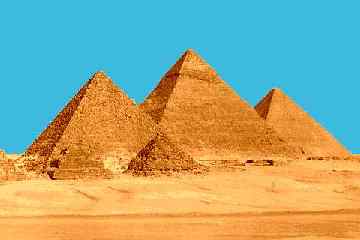
Posted on 09/25/2005 10:50:47 AM PDT by Republicanprofessor
The title of this first lecture in a new chronological series is: Greco-Roman Realism and Early Christian Abstraction.
Christian abstraction in art? How and why can that be? Well, let’s see how early art developed and why the Christians rebelled against Roman values in art and culture. This is the first “lecture” in my second series of Art Appreciation/Education classes. I figure we need to establish more of a base in how early art developed before we can explore Renaissance and other exciting periods of art.
Let’s look back even to Egyptian art, because then we can see how Greek art diverged from those forms to create greater realism. The fascinating thing about art is how the visual forms reflect the beliefs of the culture. Take a look at the pyramids: those were built about 2500 B.C. to house the mummies and fortunes of three related pharaohs: Khufu, the eldest; Khafre his son and Mycerinus the son of Kafre. The pyramids decrease in size, and in this photo Khufu’s largest pyramid is in the rear while Mycerinus’ smallest is in the foreground (with the little pyramids for his wives).

Just in case the mummified bodies decayed, there were always statues wherein the soul, or ka of the pharaoh could reside, to give him everlasting life. To stay whole forever, the statues are carved of very hard stone (often diorite) and carved in what we call closed forms (there are no parts sticking out to break off). They are cubic and rigid, somewhat like their civilization. There was very little change in Egyptian values and life for close to 3000 years. (That’s amazing; think how quickly our life and culture has changed even in the last 100 years!)


There are many, many images that look just as stiff as this, creating that eternal and unchanging quality forever.
There was one point of change in Egypt under the rule of Akhenaton c. 1390 B.C. Perhaps influenced by Judaism, he changed the former beliefs in many gods (including the pharaoh himself as a god) to a belief in one god: Aton, the sun god. He even changed his name to include -aton at the end of it. The work under his dynasty is much lighter, more lively and happier, with curves showing the appreciation of daily life and love, not the gloomy image of Osiris the god of the death and such deathy concerns. In this image of him and his family, we see an un-ideal pot belly and even the pharaoh playing with his children, something that I’ve never seen in previous Egyptian periods.

Okay, now on to Greece. What similarities and differences do you see between Mycerinus and his (loving) wife on the left and the early Greek youth (or kouros) on the right?


I hope you notice the similar pose, with one leg forward and arms held tightly by their sides. However, the Greeks are much more interested in realism, even in the sixth century B.C. There are more defined muscles and more realistic space between the parts (and thus one can also see the marks of breaks and repairs of broken limbs). My students also note the nudity. In Egyptian times, nudity was a mark of slavery, so pharaohs were always clothed in kilts. In Greek times, there was a development of humanism: the recognition of the power and potential of man. They valued the development of the mind, the body and the arts. Men often exercised nude, and the young beauty of male (and later female bodies) is often celebrated in these nude sculptures. Also note the funny grin on his face, the Archaic smile. It was a way of breathing life into mostly-stiff sculptures of this early, Archaic period.
Now, what differences do you see as Greek art develops?

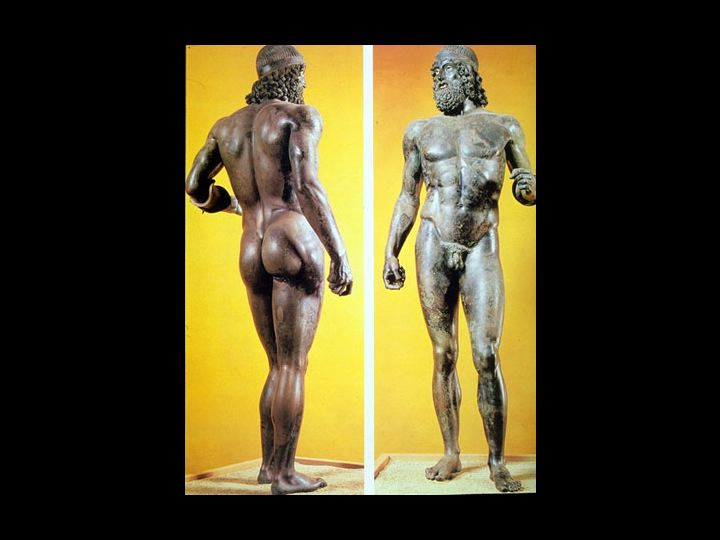

The Greeks soon discover, around 460 B.C., that if one bends the leg, one can show movement that is not possible when one’s knees are locked. This concept is called contrapposto, or weight shift. By the time we get to the Riace bronze, one of my favorites, we see all the qualities of the Severe style. This was a time of war with the Persians, and these men show a warrior’s expression and hardened bodies. The smile is gone because they are alive and seem capable of movement. Do you see a difference between the bronze statue and the even later Hermes and Dionysus? This later piece is softer; war is over and the civilization is softening. Hermes is even in what could be called a somewhat effeminate stance as he holds the baby Dionysus, about to whisk him away from jealous Hera. (Zeus, the philandering main god, is constantly conceiving illegitimate children; here Dionysus is being hurried away to a safe island. I have to say that I do think of a certain recent ex-president and his wife every time I talk about these pieces, even if I don’t know of any illegitimate offspring on their front.)


It is on the statues of women that one notices the virtuosity with drapery that the Greeks developed. The Three Goddesses, c. 440 B.C., were on the top of the Parthenon (in the triangular area called the pediment). They were watching the birth of Athena. There is a wonderful flow to their drapery as the eye travels from one to the other. The Nike of Samothrace is a later, Hellenistic work, showing very open form (that reflects the expansion of the empire under Alexander the Great). She is poised on the front of a ship, and the flowing drapery here shows the wind and sea. We are missing her head and arms, but can you imagine how they would have been shown?
The Romans admired the Greek works tremendously, and they imported and copied these sculptures en masse. These statues then decorated the splendid baths, basilicas, markets and temples. I can’t do Roman architecture justice here, but they were the first to use concrete and the arch (and related vaults and domes) to enclose tremendous spaces. The Roman people were welcomed into these spaces, and I see the arch almost like open arms to illustrate this idea. The Greeks, in contrast, really perceived their temples as sculptural backdrops to their outdoor events, altars, and ceremonies. Only a few select leaders and priests were allowed into the inner areas of Greek temples.


The Romans were a more practical people, and they excelled in specific, realistic portraiture. My favorite is of Marcus Aurelius, the only equestrian statue to survive the dark ages. (They believed for centuries that this was a sculpture of Constantine, the first Christian emperor, so they did not melt it down for the bronze.) Have you seen Gladiator? This is the old, wise emperor seen at the beginning of the film. He was also the first philosopher emperor and his Meditations still can give wise guidance to us today.
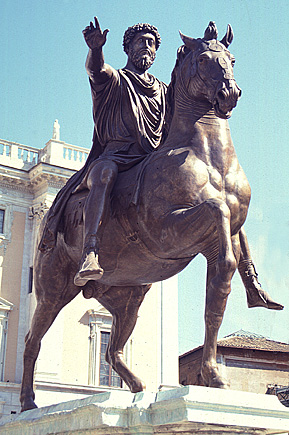
I could stop there, but I really want to make the next contrast very strongly, so I am plunging onward. Constantine recognized Christianity in 323 A.D, and the Christians were then allowed to build and create art publicly. But they wanted their work to be different from that of the Romans, and they also believed in spirituality and heaven as more important than material life here on earth. Thus their works will eschew the (wonderful) realism of Marcus Aurelius for a very flat (and yet spiritual) abstraction.
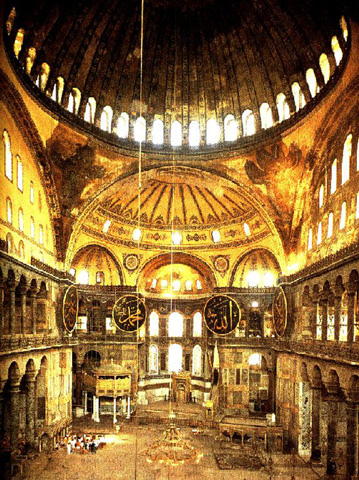



The Byzantine architects used the Roman vaulting system to create splendid basilicas where God was shown through space and light instead of graven images. The left building is Hagia Sophia from Istanbul and is now a mosque; but originally it was the private chapel of Emperor Justinian, built in only five years, 532-37 A.D. The interior decoration at the time was only golden mosaics. (The images of Jesus were added later, and the Islamic medallions even later.) The central dome reaches to 181 feet, with domes and half-domes billowing out from it, with forty windows at its base.
Justinian also built the awesome San Vitale second to the left above, at about the same time, 526-547 A.D. Its architecture is also wonderfully complex (but too much to deal with now). Inside, he had mosaics of himself and his wife. Now, how realistic are these images? Aren’t these figures as flat as paper dolls, and almost as abstract? That is because Christians did not want to stress physical, corporeal images. Instead, they are flat and body-less, concentrating on the spiritual. The gold background is typical of these Byzantine works, showing paradise.
From this point on, artists did not look or create images from life. They copied images from other art instead, so for the next 700 years Christian art is very abstract. The height of this is from the Irish manuscripts of the years 800. Three of the images below are from the Book of Kells, the Lindesfarne Gospel (from about 800) and the Gospel Book of Otto III from about 900. The others are from the twentieth century and could also be seen as spiritual in their own way. For they, too, are moving away from a tight realism to explore color and light in a free floating way.



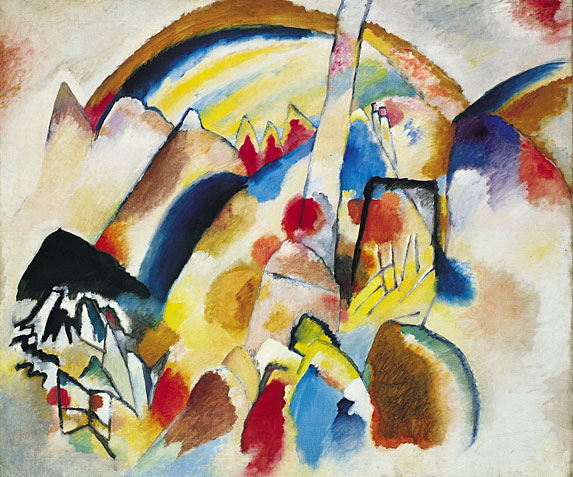

Now, I’m curious as to how Freepers respond to these abstract images. Three of them are very Christian in orientation but are also very abstract. Does that make them less effective? Abstraction is thus not blasphemous; and in this case physical realism would be sinful.
In the next “class,” we’ll see how in the Renaissance, with its “rebirth” of Greco-Roman values and humanism, artists will develop realistic anatomy with often Christian content.
|
· join list or digest · view topics · view or post blog · bookmark · post a topic · subscribe · |
|||
Antiquity Journal & archive Archaeologica Archaeology Archaeology Channel BAR Bronze Age Forum Discover Dogpile Eurekalert LiveScience Mirabilis.ca Nat Geographic PhysOrg Science Daily Science News Texas AM Yahoo Excerpt, or Link only? |
|
||
|
· Science topic · science keyword · Books/Literature topic · pages keyword · |
|||
Ooooh, thank you!
:’)
Greek ping!
Put me on the list, please.

Disclaimer: Opinions posted on Free Republic are those of the individual posters and do not necessarily represent the opinion of Free Republic or its management. All materials posted herein are protected by copyright law and the exemption for fair use of copyrighted works.